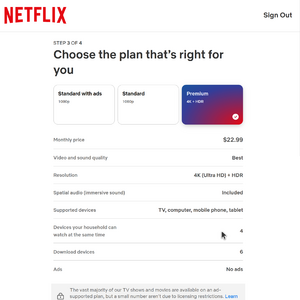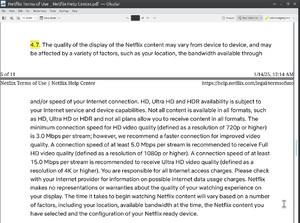Netflix stream-quality controversy
Netflix, in their Terms of Service (TOS), lists reasons why the quality of its content may vary from different devices, as stated in clause 4.7: "The quality of the display of the Netflix content may vary from device to device, and may be affected by a variety of factors, such as your location, the bandwidth available through and/or speed of your Internet connection." One of the factors not listed is the use of Widevine, a Digital Rights Management (DRM) software which is embedded into most web browsers such as Chrome, Chromium, Electron (CEF), Firefox, Edge, Opera, Safari, etc. A DRM protects media hosted on Netflix from being screen-captured, with one of the methods using "SECURE_DECODE", which uses Widevine to decode each frame displayed. This method demands more bandwidth, with Netflix appeasing the disparity by decreasing the quality to 720p on web browsers.
Currently, Netflix offers 1080p video resolution on every plan they offer on their Plans and Pricing for a subscription. Consumers who watch Netflix on web browsers will be paying for 1080p resolution while only receiving 720p resolution maximum due to DRM. The TOS allows Netflix to claim your device faulty or your internet speed slow to justify this behavior.



The only time you see there are any limitations is in incredibly small font, on the bottom of the page where you choose a plan. The 4k HDR option is the default option and has an icon with very appealing colors that draw your eyes to this more expensive option, while you must scroll to the bottom to even be linked to a document that explains the limitations. [1] The explanation provided on this terms of service that must be dug through, is completely inadequate. See below:
Netflix Resolution Limitations in Terms of Service
Terms of Service Analysis
Netflix's Terms of Service (TOS) obscures important information about video quality limitations in Section 4.7, which vaguely states:
"HD, Ultra HD and HDR availability is subject to your Internet service and device capabilities. Not all content is available in all formats, such as HD, Ultra HD or HDR and not all plans allow you to receive content in all formats."
Currently, Netflix offers 1080p video resolution on every plan they offer on their Plans and Pricing for a subscription. Consumers who watch Netflix on web browsers will be paying for 1080p resolution while only receiving 720p resolution maximum due to DRM. The TOS allows Netflix to claim your device faulty or your internet speed slow to justify this behavior.
Terms of Service Analysis
Netflix's Terms of Service (TOS) obscures important information about video quality limitations in Section 4.7, which vaguely states:
4.7. The quality of the display of the Netflix content may vary from device to device, and may be affected by a variety of factors, such as your location, the bandwidth available through and/or speed of your Internet connection. HD, Ultra HD and HDR availability is subject to your Internet service and device capabilities. Not all content is available in all formats, such as HD, Ultra HD or HDR and not all plans allow you to receive content in all formats. The minimum connection speed for HD video quality (defined as a resolution of 720p or higher) is 3.0 Mbps per stream; however, we recommend a faster connection for improved video quality. A connection speed of at least 5.0 Mbps per stream is recommended to receive Full HD video quality (defined as a resolution of 1080p or higher). A connection speed of at least 15.0 Mbps per stream is recommended to receive Ultra HD video quality (defined as a resolution of 4K or higher). You are responsible for all Internet access charges. Please check with your Internet provider for information on possible Internet data usage charges. Netflix makes no representations or warranties about the quality of your watching experience on your display. The time it takes to begin watching Netflix content will vary based on a number of factors, including your location, available bandwidth at the time, the Netflix content you have selected and the configuration of your Netflix ready device.
Currently, Netflix offers 1080p video resolution on every plan they offer on their Plans and Pricing for a subscription. Consumers who watch Netflix on web browsers will be paying for 1080p resolution while only receiving 720p resolution maximum due to DRM. The TOS allows Netflix to claim your device faulty or your internet speed slow to justify this behavior.
Key Issues
- Lack of Transparency
- The TOS does not explicitly list supported hardware
- The TOS claims the issue may be your device's capabilities, without mentioning that Netflix places specific limitations on what devices are capable of.
- Whether a device is CAPABLE of high bitrate, 4k video playback is not the issue; Netflix chooses to send a low bitrate, low resolution stream to specific devices, and does not provide you with the prerequisites necessary to receive a 4k stream. . The reality is that Netflix ACTIVELY LIMITS what devices will work in 4k without disclosing what those limits are to you.
- No clear information about browser limitations to 720p due to DRM
- No direct way to determine if a device is "Netflix ready"
- Buried Information
- The only time you see there are any limitations is in incredibly small font, on the bottom of the page where you choose a plan
- The 4k HDR option is the default option and has an icon with very appealing colors that draw your eyes to this more expensive option
- Users must scroll to the bottom to even be linked to a document that explains the limitations
- Inadequate Disclosure
- Section 4.9 deflects responsibility by telling users to "look solely to the entity that manufactured and/or sold you the Netflix ready device"; without providing any information to you, or the manufacturer of your computer/operating system, on what prerequisites exist for that device to receive a 4k stream from netflix.
- The explanation provided in the terms of service, which must be dug through, is completely inadequate
- No clear guidance on how to determine device compatibility before subscribing
This represents a modern consumer protection issue where technical limitations put in place by the vendor to retain control over your experience negatively affect service quality and are obscured from consumers at the point of purchase; while still charging premium prices for resolutions that they knowingly restrict many devices, browsers, operating systems, and hardware form playing back; even if they are fully capable of doing so.
